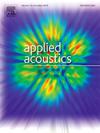通过隔声耦合设计实现单相疏形声元结构低频带隙展宽
IF 3.4
2区 物理与天体物理
Q1 ACOUSTICS
引用次数: 0
摘要
隔声技术长期以来一直是一门具有实用价值的热门学科,因为它可以减少车辆行驶时产生的严重噪音。在本研究中,提出了一种单相shuriken类声学超材料(SSAM),通过梯度耦合设计来拓宽低频带隙。基于Bloch定理和有限元模拟方法,研究了色散关系和透射率,研究了结构几何参数对带隙的影响。最宽带隙可达197.55 Hz,最低频率可降至54.96 Hz。通过梯度耦合和混合耦合设计,构建了具有低频连续带隙的几种元结构组合。在1 ~ 10000 Hz频率范围内计算的透射率显示出有效和完美衰减宽度的良好增加。结合局部共振机制和有效质量弹簧系统,定性分析了几何构型和参数对带隙变化趋势的影响。通过数值模拟得到了SSAM的插入损耗,并进行了实验验证。实验结果表明,SSAM在870 Hz时具有24.9 dB的高IL值。结果表明,采用质量分布和周期排列的SSAM结构可以通过降低带隙的开启频率来实现良好的宽带声传输损失。提出的单相结构耦合设计策略有利于有效地利用大规模低频降噪,促进了其潜在的工程应用。该研究为蜂窝结构在复杂低频噪声环境下产生宽带隙提供了一种新的有效方法。本文章由计算机程序翻译,如有差异,请以英文原文为准。

Low-frequency bandgap broadening of single-phase shuriken-like acoustic metastructure through coupling design for sound insulation
Sound insulation has long been a prosperous subject with practical interest because it can reduce severe noise from moving vehicles. In this study, a single-phase shuriken-like acoustic metamaterial (SSAM) is proposed to broaden the low-frequency bandgap through gradient coupling design. Based on Bloch's theorem and finite element simulation method, the dispersion relation and transmission are studied, and the influence of structural geometric parameters on bandgap is investigated. The widest bandgap can reach 197.55 Hz, and the lowest frequency can be reduced to 54.96 Hz. Several combinations of metastructures with low-frequency continuous bandgap are constructed by gradient and hybrid coupling design for the SSAM structures. The calculated transmission in the frequency range of 1 to 10000 Hz showed an excellent increase in effective and perfect attenuation width. The influence of geometric configuration and parameters on the trend of the bandgap is qualitatively analyzed by combining the local resonance mechanism and an effective mass-spring system. The insertion loss (IL) of SSAM is obtained through numerical simulation, which is verified by the experiment. The experimental results show that the SSAM exhibits a high-pitched IL value of 24.9 dB at 870 Hz. These results indicate that the proposed SSAM configuration with distributed masses and periodical arrangement can realize a good broadband sound transmission loss (TL) by decreasing the opening frequencies of bandgaps. The proposed strategy of single-phase structural coupling designs facilitates the use of large-scale low-frequency noise canceling efficiently, promoting its potential engineering application. This work provides a new and effective method for generating wide bandgaps of honeycomb structures in complex low-frequency noise environments.
求助全文
通过发布文献求助,成功后即可免费获取论文全文。
去求助
来源期刊

Applied Acoustics
物理-声学
CiteScore
7.40
自引率
11.80%
发文量
618
审稿时长
7.5 months
期刊介绍:
Since its launch in 1968, Applied Acoustics has been publishing high quality research papers providing state-of-the-art coverage of research findings for engineers and scientists involved in applications of acoustics in the widest sense.
Applied Acoustics looks not only at recent developments in the understanding of acoustics but also at ways of exploiting that understanding. The Journal aims to encourage the exchange of practical experience through publication and in so doing creates a fund of technological information that can be used for solving related problems. The presentation of information in graphical or tabular form is especially encouraged. If a report of a mathematical development is a necessary part of a paper it is important to ensure that it is there only as an integral part of a practical solution to a problem and is supported by data. Applied Acoustics encourages the exchange of practical experience in the following ways: • Complete Papers • Short Technical Notes • Review Articles; and thereby provides a wealth of technological information that can be used to solve related problems.
Manuscripts that address all fields of applications of acoustics ranging from medicine and NDT to the environment and buildings are welcome.
 求助内容:
求助内容: 应助结果提醒方式:
应助结果提醒方式:


